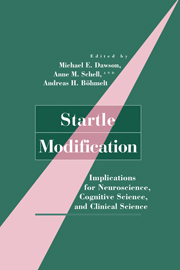Book contents
- Frontmatter
- Contents
- Contributors
- Preface
- Prologue: A Historical Note on the “Discovery” of Startle Modification
- 1 Startle Modification: Introduction and Overview
- PART I BASIC PARADIGMS, METHODS, AND PHENOMENA
- PART II PHYSIOLOGICAL MEDIATION OF STARTLE MODIFICATION
- 5 Neurophysiology and Neuropharmacology of Startle and Its Affective Modification
- 6 Neurophysiology and Neuropharmacology of Short Lead Interval Startle Modification
- PART III PSYCHOLOGICAL MEDIATION OF STARTLE MODIFICATION
- PART IV INDIVIDUAL DIFFERENCES AND STARTLE MODIFICATION
- PART V RELATIONSHIPS WITH OTHER PARADIGMS AND MEASURES
- References
- Author Index
- Subject Index
5 - Neurophysiology and Neuropharmacology of Startle and Its Affective Modification
Published online by Cambridge University Press: 26 March 2010
- Frontmatter
- Contents
- Contributors
- Preface
- Prologue: A Historical Note on the “Discovery” of Startle Modification
- 1 Startle Modification: Introduction and Overview
- PART I BASIC PARADIGMS, METHODS, AND PHENOMENA
- PART II PHYSIOLOGICAL MEDIATION OF STARTLE MODIFICATION
- 5 Neurophysiology and Neuropharmacology of Startle and Its Affective Modification
- 6 Neurophysiology and Neuropharmacology of Short Lead Interval Startle Modification
- PART III PSYCHOLOGICAL MEDIATION OF STARTLE MODIFICATION
- PART IV INDIVIDUAL DIFFERENCES AND STARTLE MODIFICATION
- PART V RELATIONSHIPS WITH OTHER PARADIGMS AND MEASURES
- References
- Author Index
- Subject Index
Summary
ABSTRACT
This chapter describes the neural pathways involved in the acoustic startle reflex itself and those involved in modification of startle by fear and stress. In the rat, the primary acoustic startle pathway probably involves three synapses onto (1) cochlear root neurons, (2) neurons in the nucleus reticularis pontis caudalis, and (3) motoneurons in the facial motor nucleus (pinna reflex) or spinal cord (whole body startle). The excitatory amino acid glutamate may well mediate startle at each of the three central synapses along the acoustic startle pathway. Startle can be potentiated by eliciting the reflex in the presence of a cue that has previously been paired with shock. This effect is blocked by chemical lesions or chemical inactivation of the amygdala. Very high levels of fear may fail to lead to increased startle because of activation of a brain area (the periacqueductal gray) which produces active escape behavior incompatible with startle. Startle also can be increased by sustained exposure to bright light or intraventricular administration of the stress peptide corticotropin-releasing hormone. These effects depend on a brain area called the bed nucleus of the stria terminalis. These results suggest that different brain areas may be involved in short-term increases in startle, akin to stimulus-specific fear, versus longer-lasting increases in startle, akin to anxiety.
Introduction
A major advantage of using the acoustic startle reflex to study behavior is that the startle reflex itself has an extraordinarily short latency (e.g., in rats, 8 msec measured electromyographically in the hind leg).
- Type
- Chapter
- Information
- Startle ModificationImplications for Neuroscience, Cognitive Science, and Clinical Science, pp. 95 - 113Publisher: Cambridge University PressPrint publication year: 1999
- 34
- Cited by

